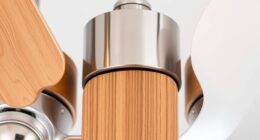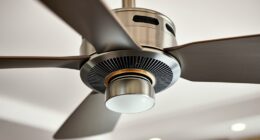To quickly balance a wobbly ceiling fan, start by gathering tools like a screwdriver, small level, and a fan balancing kit. Turn off the power and secure the fan. Inspect and adjust the blades for misalignment or damage, then use a balancing kit to add weights where needed. For fine-tuning, slide a coin or small object along the blades to identify wobble spots. Proper adjustments reduce noise and vibration — keep exploring for detailed tips to perfect your fan’s balance.
Key Takeaways
- Turn off power, remove blades, and clean them to ensure proper alignment and balance.
- Use a small level to check blade parallelism and adjust misaligned blades accordingly.
- Apply balancing weights from a kit or a coin on the blades to correct wobble.
- Shift weights gradually along the blade edge, testing stability after each adjustment.
- Reassemble, turn on the fan, and verify smooth operation, making further tweaks if needed.
Gather Your Tools and Prepare the Fan

Before you begin balancing your ceiling fan, gather all the necessary tools and make certain the fan is turned off and safely supported. Start by collecting a screwdriver, a small level, and a tape measure. If your fan has decorative fan covers, remove them carefully to access the blades and check for dust or debris that could cause wobbling. Keep your remote control handy for troubleshooting issues later, like unresponsive commands that might interfere with adjustments. Once everything is in place, inspect the blades for damage or uneven wear. Ensuring the fan operating hours of your remote or other electronic devices can help prevent interference during the balancing process. Having these tools ready streamlines the process, saving time and avoiding interruptions. Proper preparation ensures you can efficiently balance your fan without unnecessary delays, making the entire process smoother and more effective.
Turn Off and Secure the Fan
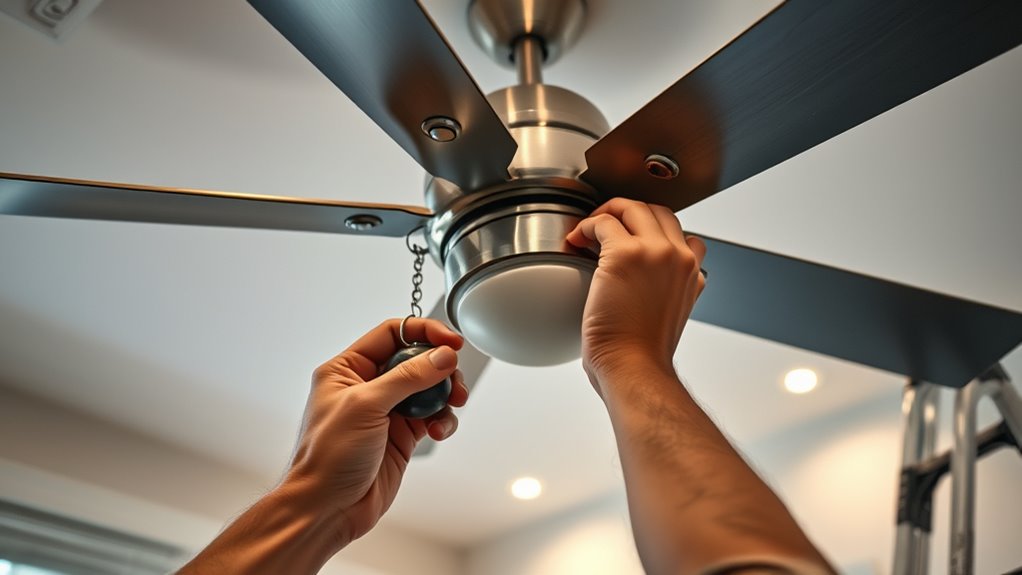
To guarantee safe and effective balancing, you need to turn off and secure the ceiling fan first. Always follow safety precautions by switching off the fan at the wall switch, then disconnecting the power supply at the circuit breaker to prevent electrical hazards. Confirm that the fan blades have come to a complete stop before handling. Secure the fan by gently stabilizing it or using a sturdy ladder to prevent movement while working. Ignoring electrical considerations can lead to shocks or damage, so double-check that the power is off before touching any wiring or components. Securing the fan ensures your safety during the balancing process and prevents accidental falls or injuries, setting the stage for a smooth and efficient repair. Additionally, understanding the types of portable camping gear can help in preparing for outdoor activities once the repair is complete. Properly securing and turning off your fan aligns with safety precautions that are essential in any maintenance task. Being aware of home improvement safety practices can further reduce risks during the balancing process.
Check and Adjust the Fan Blades
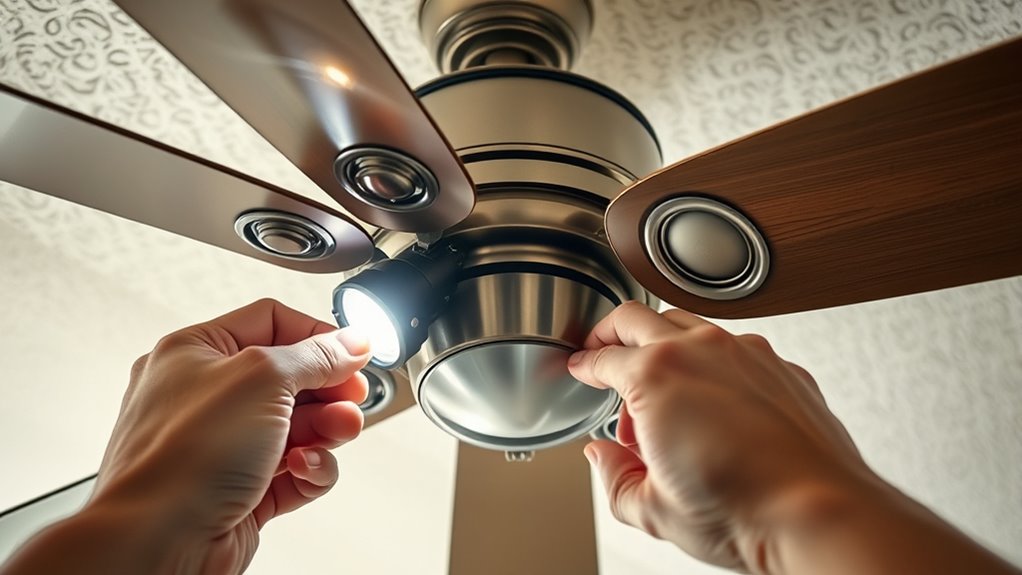
Once you’ve turned off and secured the fan, it’s time to check the blades for any signs of damage or misalignment. Look for bent or cracked blades, which can cause wobbling and increase vibration. Use a straightedge or level to assess the blade alignment; they should be even and parallel. If a blade appears out of line, gently adjust it by loosening the blade screw and repositioning it. Proper blade alignment is essential for vibration reduction, ensuring the fan runs smoothly. After making adjustments, tighten all screws securely. Double-check that all blades are evenly spaced and aligned. Maintaining fan components can prevent wobbling and prolong the lifespan of your ceiling fan. Ensuring the blades are free from debris and dust can improve performance and prevent wobbling. Regularly inspecting the blades for imbalances and cleaning them can considerably improve fan stability and quietness, making your ceiling fan operate more efficiently and safely.
Balance the Blades With a Fan Balancing Kit
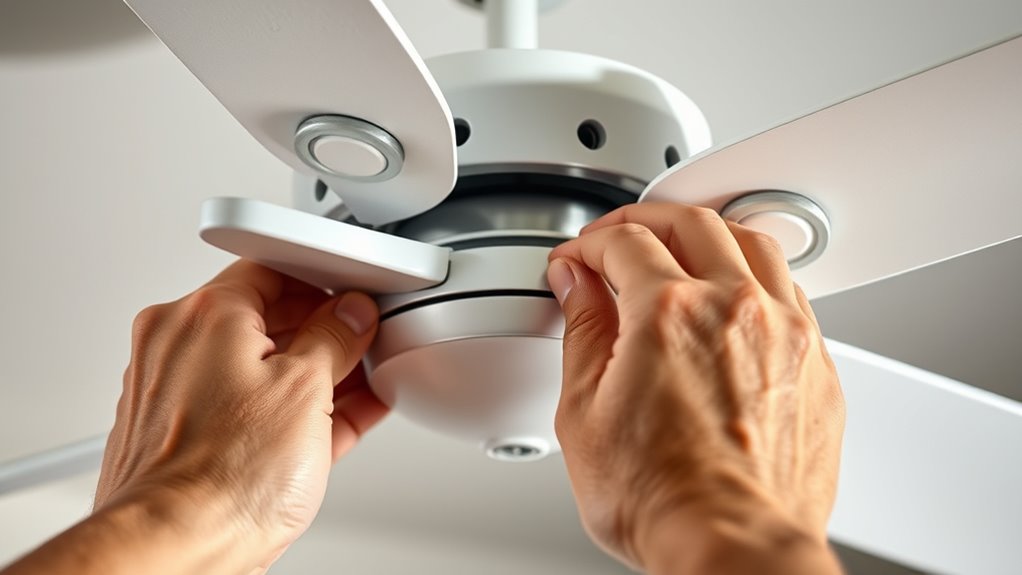
If your ceiling fan still wobbles after checking and adjusting the blades, balancing them with a fan balancing kit can make a big difference. These kits typically include weights that you attach to the blades to even out any imbalance. Before applying the weights, turn off the fan and ensure the motor speed is consistent, as irregular motor speeds can cause wobbling. While installing the weights, double-check your electrical wiring to confirm all connections are secure, since loose wiring can cause vibrations. Once the weights are in place, turn the fan back on and observe its stability. Proper blade balance reduces strain on the motor and prevents uneven wear, keeping your fan running smoothly and quietly. Additionally, understanding relationship dynamics can help you better interpret any signs of imbalance or issues with your fan setup. Recognizing how vibrations relate to both mechanical and electrical factors can assist in diagnosing persistent wobbling issues. Incorporating automation in business concepts, such as scheduled maintenance, can also help prevent future wobbling by ensuring components are regularly checked and maintained.
Use a Coin or Small Object for Fine Tuning
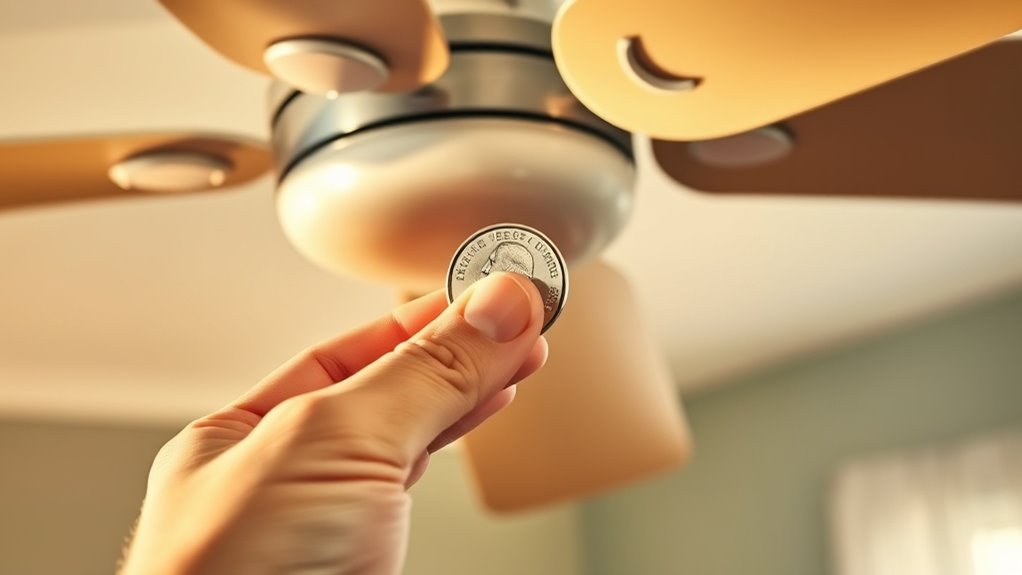
Choose a coin with a flat, smooth surface that can stay in place without slipping. Small objects like washers or paper clips also work well for fine adjustments. Carefully move the coin or object along the blade to find the exact spot that stops the wobbling. Using a paint sprayer tip compatible with your equipment ensures a smoother, more consistent finish after balancing.
Selecting the Right Coin
Using a coin or small object for fine-tuning allows you to make precise adjustments to your ceiling fan’s balance. When selecting the right coin, focus on consistency; a standard coin, like a quarter, often works best because of its uniform weight. The key is to choose a coin that can be easily placed on the blade without slipping. Proper coin placement is essential—place the coin on different blades to test how it affects wobbling. Pay attention to weight distribution, ensuring the coin adds just enough weight to counteract imbalance. Avoid using coins that are too thick or irregular in size, which can throw off your adjustments. Consistent, small changes will help you achieve a smooth, balanced fan in less time. Additionally, understanding gently balancing glycolic acid treatments can be analogous to fine-tuning—small, precise adjustments lead to the best results. For optimal results, consider the specific weight of the coin relative to your fan’s size and weight. Recognizing the importance of proper maintenance can prevent future imbalance issues and prolong the life of your ceiling fan.
Fine Adjustment Techniques
Wondering how to make precise adjustments to your ceiling fan’s balance? Fine-tuning with a coin or small object can make a big difference. Start by performing vibration analysis to identify which blades cause wobbling. A vibrational state analysis can help pinpoint the specific blades that need adjustment, ensuring targeted corrections. Next, carefully move the coin along the blade’s edge to modify blade alignment, testing after each shift. You can also inspect the dog breed traits or characteristics to better understand the type of fan or blades that may be more prone to imbalance. Finally, observe the fan’s movement to see if wobbling decreases. Here are the steps to follow: 1. Conduct vibration analysis to pinpoint unbalanced blades. 2. Use the coin to fine-tune blade alignment by sliding it along the blade’s edge. 3. Test the fan’s balance after each adjustment, ensuring wobble diminishes. This method ensures precise, subtle corrections, helping you achieve a smooth, wobble-free ceiling fan in no time. Regular maintenance can prevent further imbalance issues and prolong your fan’s lifespan.
Reassemble and Test the Fan
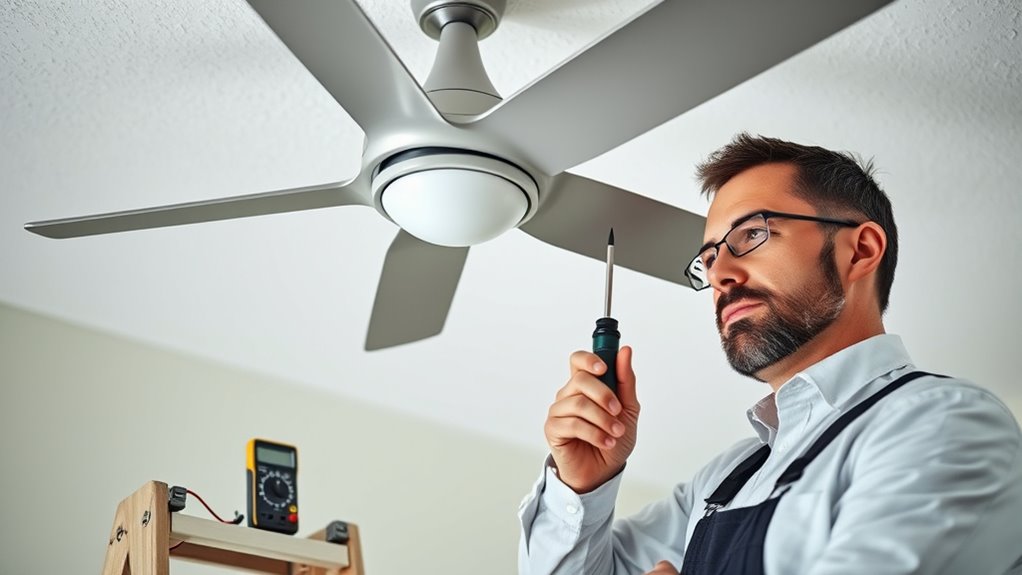
After ensuring all parts are securely reattached, carefully lift the fan and position it onto the mounting bracket. Once mounted, reconnect the wiring, making sure each connection is tight and correct. Turn on your ceiling fan to test its stability and check for wobbling. Observe the fan’s movement and listen for any unusual noises. If your fan features decorative lighting, verify that the lights operate properly and don’t cause imbalance. Consider the style of your ceiling fan—whether modern, traditional, or contemporary—and ensure the balance feels right for your space. If wobbling persists, you may need to make further adjustments or check for misaligned blades. Regular maintenance, such as filter replacement, can help ensure optimal performance and reduce wobbling issues. Additionally, inspecting the balance of fan blades periodically can prevent future wobbling and prolong the life of your fan. Testing the fan now confirms whether your balancing efforts were successful or if additional tweaks are needed.
Prevent Future Wobbling With Regular Maintenance
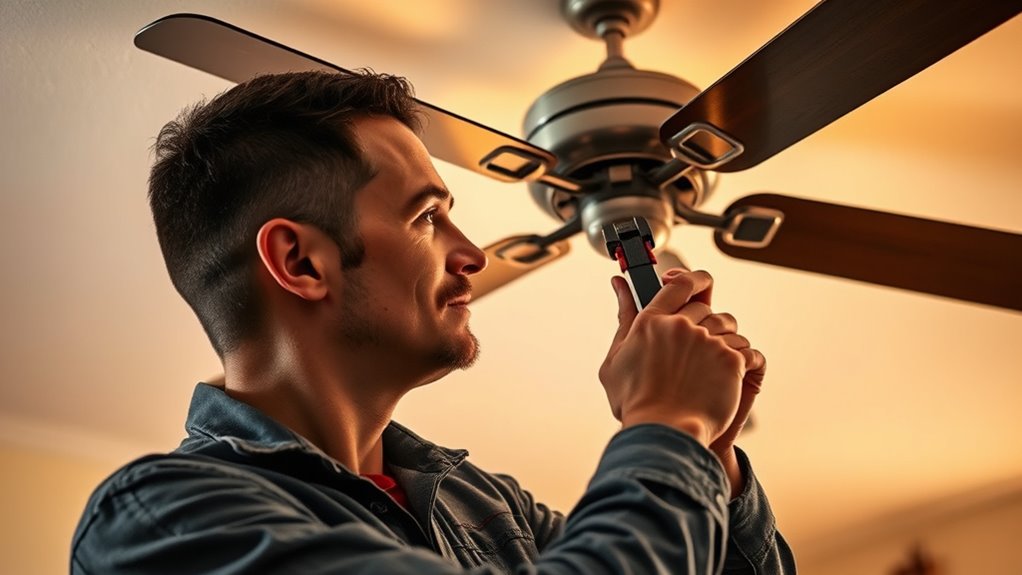
Regular maintenance is key to preventing future wobbling and ensuring your ceiling fan operates smoothly. Incorporate routine checks and cleaning to keep the blades balanced and secure. To maintain peak performance, consider these ventilation tips and how different ceiling fan styles can impact stability:
Regular maintenance keeps ceiling fans balanced and wobble-free for optimal performance.
- Inspect blades regularly, making sure they’re free of dust and debris, which can cause imbalance.
- Tighten mounting hardware and blade screws to prevent wobbling caused by loose parts.
- Balance blades periodically using a balancing kit, especially if you switch between ceiling fan styles or change their orientation.
Frequently Asked Questions
How Often Should I Check My Ceiling Fan for Wobbling Issues?
You should check your ceiling fan for wobbling issues every few months. Regularly inspecting fan blade alignment guarantees they stay even, preventing wobble. Also, listen for unusual motor noise, which can indicate imbalance or loose parts. Addressing these early helps avoid bigger problems later. If you notice wobbling or noise, it’s a good idea to balance the blades or tighten components promptly, keeping your fan running smoothly and quietly.
Can a Ceiling Fan Wobble Due to Improper Installation?
Yes, a ceiling fan can wobble due to improper installation. If the fan blade alignment isn’t correct or the mounting stability isn’t secure, it causes imbalance and wobbling. When installing, verify the blades are aligned properly and the mounting bracket is tightly secured. Poor installation can lead to persistent wobbling, so double-check these aspects to keep your fan running smoothly and quietly.
What Are the Signs That My Fan Blades Need Replacing?
Imagine your fan blades as the wings of a bird—if they’re chipped, warped, or cracked, the flight becomes uneven. Signs you need fan blade replacement include persistent wobbling, unusual noise, or visible damage. If balancing doesn’t help, it’s time for motor troubleshooting and blade replacement. Ignoring these signs can strain the motor, reducing efficiency and risking further damage to your ceiling fan.
Is It Safe to Balance a Fan While It’S Still Mounted?
Balancing your ceiling fan while it’s mounted is generally safe if you follow proper safety precautions. Make sure to turn off the fan and secure the blades before starting DIY tips like adjusting blade weights or using a balancing kit. Use a sturdy ladder and wear gloves for protection. Taking these steps guarantees you fix the wobble securely without risking injury or damage. Always prioritize safety when working on ceiling fans.
How Do I Identify if the Fan Motor Is the Cause of Wobbling?
If you notice persistent wobbling, it’s essential to check for fan motor issues during your wobble diagnosis. You might see the motor’s mounting or blades vibrating, indicating misalignment or loose connections. Turn off the fan and gently inspect the motor for signs of wear or damage. If the wobble continues despite blade adjustments, the motor could be misaligned or faulty, requiring further inspection or professional repair.
Conclusion
Now that you’ve balanced your ceiling fan, you can enjoy a quieter, wobble-free breeze. Regular maintenance keeps it running smoothly and prevents future issues. Why settle for constant noise and imbalance when a quick fix can restore its proper function? With just a few minutes and the right tools, you’ve made your fan as good as new. So, why not take a moment now to guarantee it stays steady and safe for years to come?







